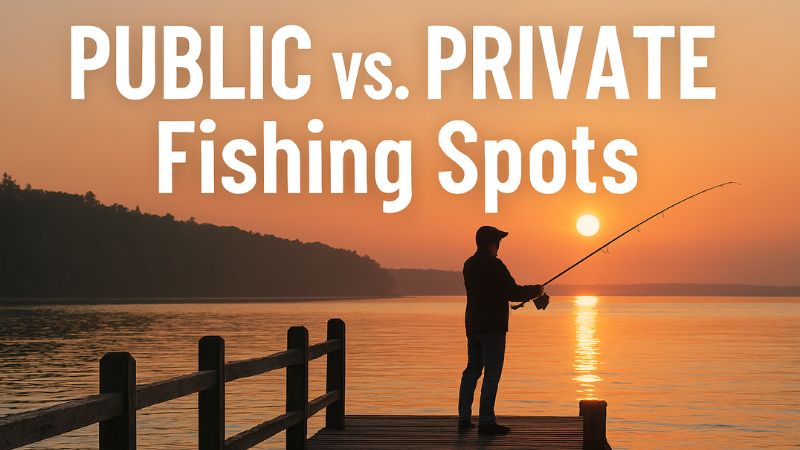Public vs. Private Fishing Spots: Pros, Cons & How to Access
Among anglers, there’s an ongoing conversation about whether the best catches come from public fishing spots or private fishing spots. Some swear by the thrill of casting a line in public lakes and rivers, while others prefer the comfort and control of a private lake membership.
At the heart of this choice are fishing location access, fishing rights, and fishing regulations. Knowing where you stand — legally and practically — can save you time, money, and potential headaches. This guide will compare public vs private waters, break down the pros and cons, and explain how to access each type so you can plan your trips with confidence.
Understanding the Basics
What Are Public Fishing Spots?
Public fishing spots are waters open for everyone to fish, often managed by state parks, national parks, or local authorities. Examples include:
- Public lakes and rivers
- State park fishing areas
- National park fishing zones
- Navigable waters like tidal rivers and large bays
These areas are typically maintained using public funds, and agencies handle fish population management, overfishing prevention, and habitat care.
What Are Private Fishing Spots?
Private fishing spots are owned or leased by individuals, clubs, or organizations. Common examples include:
- Private lakes & ponds accessible through private lake membership
- Pay to fish ponds where you pay a day pass cost for access
- Fishing club access via annual fees
- Invitation‑only spots with landowner fishing permission
Here, the owner controls maintenance, often funding fish stocking programs, adding amenities, and setting restricted fishing rules.
Pros and Cons of Public Fishing Spots
Advantages
- Budget fishing trips – Most only require a state fishing license and sometimes a low day pass fishing permit.
- Variety – From fishing pier access on coastal waters to inland public lakes and rivers, options are plentiful.
- Accessible fishing locations – Public ramps, docks, and designated shorelines make it easy for anyone to fish without a membership.
Disadvantages
- Overcrowding – Peak seasons can pack the shoreline shoulder‑to‑shoulder.
- Maintenance quality – Water quality and facilities may vary by location.
- Overfishing prevention challenges – High traffic can pressure fish populations, leading to stricter catch and release rules or fishing season restrictions.
Pros and Cons of Private Fishing Spots
Advantages
- Controlled access fishing – Limited anglers means less competition and quieter surroundings.
- Better management – Regular fish stocking programs keep trophy fishing locations healthy.
- Added comfort – Amenities like boat rentals, cleaning stations, or even guided trips enhance the experience.
Disadvantages
- Fishing membership fees or day pass cost can be expensive.
- Seasonal access – Some close for spawning seasons or due to owner schedules.
- Restricted fishing rules – The owner may set species limits, technique restrictions, or even required gear types.
Cost Comparison: Public vs. Private
| Expense Type | Public Waters | Private Waters |
|---|---|---|
| Permit or License | State or local license (low cost) | Membership or day pass cost |
| Travel | Fishing travel expenses can be the same for both | Same as public |
| Amenities | Basic or none | Enhanced (boat rentals, guides) |
| ROI | Higher for casual anglers seeking value for money fishing | Higher for serious anglers chasing trophy fishing locations |
For occasional anglers, public fishing spots offer the best value for money fishing. Dedicated anglers may see better returns from fishing membership fees if they use the access often.
Legal and Regulatory Considerations
Licensing Requirements
- Fishing license requirements vary by state. Most public waters require a valid state fishing license.
- Some species need day pass fishing permits or species regulations compliance.
Access Rights
- Property boundary laws mean private waters need landowner fishing permission.
- Trespassing regulations protect landowners; crossing onto private waters without consent is illegal.
- Some areas benefit from riparian rights or the public trust doctrine, granting public access along navigable waters, even if the shoreline is private.
How to Access Each Type
Accessing Public Spots
- Check state or local park websites for maps and open seasons.
- Visit community boards or fishing forums for location reports.
- Local tackle shops often have tips on boat ramp access, fishing pier access, and seasonal bites.
Accessing Private Spots
- Join a fishing club or lodge with fishing club access perks.
- Purchase pay to fish ponds passes for single‑day trips.
- Build relationships with landowners and ask politely for landowner fishing permission — bring a small gift or offer to share your catch.
Which Is Right for You?
- Beginner on a budget – Stick to public waters for learning and affordability.
- Trophy hunter after rare species – Invest in trophy fishing locations through private lake membership or guided trips.
- Family fishing trips – Many state parks have picnic areas, safe shorelines, and restrooms.
- Competitive angler access – Private clubs often hold tournaments with structured rules and prizes.
Tips for Making the Most of Your Choice
For Public Spots
- Visit early mornings or weekdays for the best fishing times and fewer crowds.
- Use satellite maps and local advice for scouting fishing locations.
- Respect catch and release rules and fishing season restrictions to help fish population management.
For Private Spots
- Make full use of maximizing fishing membership benefits: attend events, use guest passes, and explore all waters available to you.
- Network for exclusive fishing access and improve chances for seasonal access invites to prime waters.
Conclusion
Public vs private waters each have their place in the angling world. Public fishing spots are accessible, budget‑friendly, and diverse. Private fishing spots bring comfort, exclusivity, and often better fish quality; for a price. Your choice comes down to budget, fishing style, and the kind of environment you enjoy most.
If you respect fishing rights and follow fishing regulations, you can enjoy both types. Many anglers mix the two; casting from a fishing pier access one weekend and heading to a private lake membership trip the next.
FAQs
1. Do I need a license for both public and private fishing spots?
Yes, most states require a state fishing license for both, though some private owners include day pass fishing permits in access fees.
2. Can private landowners stop me from fishing a river?
If the river is navigable under the public trust doctrine, you can fish the waterway, but respect property boundary laws and avoid trespassing on the banks.
3. Are fish stocking programs common in public lakes?
Yes, many wildlife management agencies run stocking schedules, especially for high‑traffic public lakes and rivers.
4. What’s the biggest advantage of private fishing spots?
Consistently better fish population management and amenities like boat rentals or guided services.
5. How can I find hidden public spots?
Ask locals, check community boards, and study maps for less popular public waters.
6. Do all public spots have catch and release rules?
Not all; catch and release rules vary by location and are often tied to species regulations.
7. Are fishing membership fees worth it for casual anglers?
For occasional trips, budget fishing trips at public spots often deliver better value for money fishing.
8. What happens if I fish on private land without permission?
You could face fines under trespassing regulations and lose any gear left on site.
9. Can I access private lakes without paying?
Only with landowner fishing permission; otherwise, you’ll need a pay to fish ponds pass or private lake membership.
10. Are national park fishing areas as good as private waters?
National park fishing offers scenic value and diverse species, but fish size and comfort levels can vary compared to trophy fishing locations in private waters.

